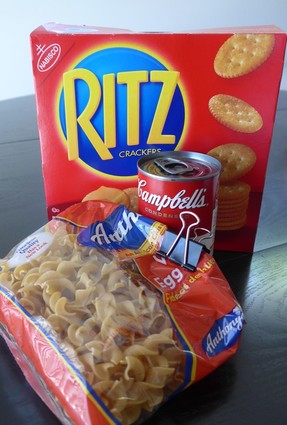|
My church periodically provides meals at the local homeless shelter, and recently I volunteered to help. The coordinator sent the cooks a casserole recipe which had condensed cream of mushroom soup, egg noodles, diced chicken, frozen peas, and a topping of crushed Ritz Crackers. “How retro!” I said. I don’t usually cook this way. I’m more likely to make a soup from dried beans and fresh vegetables. This casserole didn’t even use chopped onions and garlic, instead substituting onion and garlic powder. Of course, I realized why the leader chose this recipe. It’s easy, so that someone with rudimentary cooking skills or limited time can make it. It’s not spicy, so the children at the shelter will eat it (and yes, children live at this shelter, where there’s play equipment and transportation to local schools). But I balked a little at cooking something for the homeless that I wouldn’t cook for myself. As I boiled egg noodles and opened soup cans, though, the recipe started looking familiar. It was like a tuna noodle casserole with chicken instead of tuna. When I was growing up, I ate a lot of tuna casserole. My parents had six children, so every night my mother had to cook for eight people. Eight people! When I make a pot of soup, I freeze three quarters of it, providing multiple easy meals for the future. My mother prepared a mind-boggling amount of food; she and Dad bought two carts full at the grocery store every week; plus, many days she walked to the store to supplement the weekly shopping. If I had to cook that much, I’d make anything that didn’t take all day and that my kids would eat. After assembling the casserole, I swiped a fingerful of sauce from the mixing bowl. Pretty tasty. And as it baked the familiar smell permeated the house—a comfort smell. A smell of home.
4 Comments
I spent my mornings recently working on some wooden Adirondack chairs that after summer’s heat and winter’s rains needed some cracks filled and a new coat of paint. I washed, spread wood putty, sanded, wiped with tack cloths, then got out my paintbrush and started applying primer. I thought I was being pretty careful. When I went to put the first coat of paint over the primer, though, I found drips on the arms, back, and even the seat, where the primer had run through when I was covering the chairs’ undersides. I made a halfhearted attempt to sand off the worst drips before saying screw it and just painting over them. And though I again tried to be careful, after two coats of paint, the drips had multiplied. From far away, the chairs look great. But anyone examining them will find many flaws in my paint job. Thing is, I don’t really care. They’re good enough for me.
Many versions of the 80/20 rule exist, but the one I first heard, and took to heart, is that 20% of the effort gives you 80% of the results. For many undertakings, 80% is enough. Take cooking. When I make soup, my vegetables are not chopped finely—especially onions, which make my eyes water so much that I hurry through the job, producing large, uneven chunks. But who cares? It’s just soup. I’m eating it. I’m not putting pictures on Instagram or Facebook. And even if I did, I wouldn’t care. An 80% job (maybe even less) is fine. However, sometimes 80% is not good enough. In my writing, I’ll take a word out one day and put it back the next. I’ll read out loud with different inflections to test the rhythm and sound. I’ll feel a story is close, even know it could be published somewhere, but still hold it back because I’m not satisfied it’s as good as I can make it. I sand off every drip. Sometimes, after a particularly dispiriting stretch of rejections, or of wrestling with a novel ending or a story opening, of starting work and cutting most of what I wrote the day before, I want to give up on writing. But when I think of how hard I work to get that extra 20% I know I have to keep at it. Because anything I take such pains with is important to me. Show me where you spend your time, and I’ll show you what you value. |
Author
Ann Hillesland writes fiction and essays. Her work has appeared in many literary journals, including Fourth Genre, Bayou, The Laurel Review, and Sou’wester. Categories
All
Archives
February 2024
© Ann Hillesland 2015-2017. Unauthorized use and/or duplication of this material without express and written permission from this site’s author is strictly prohibited. Excerpts and links may be used, provided that full and clear credit is given to Ann Hillesland with specific direction to the original content.
|


 RSS Feed
RSS Feed